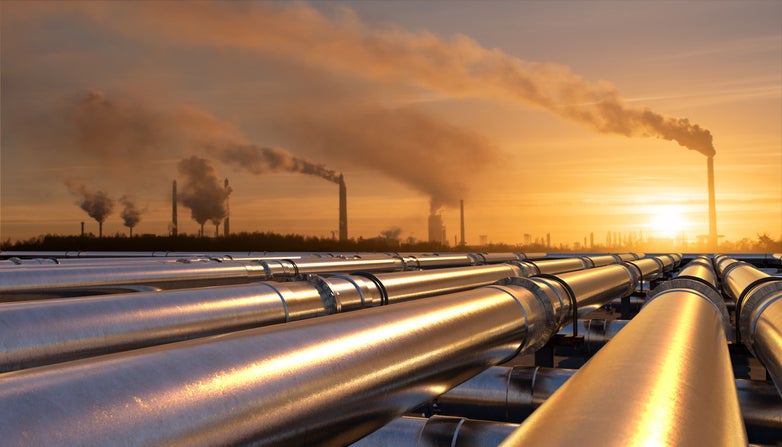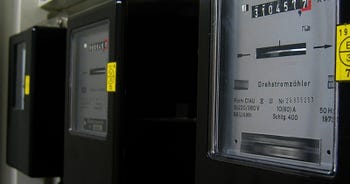How is energy bought and sold and how does this affect prices?
If you’ve ever wondered why the price you pay for energy doesn’t seem to quite tally with rising and falling wholesale prices, it’s largely down to the way energy is bought and sold and the level of risk faced by suppliers.
To give you an idea of how it all works, let’s take a closer look at what the energy market is and how gas and electricity are bought and sold.

Five-point summary
- Energy suppliers buy electricity and gas from generators through the wholesale market and sell it to consumers via the retail market. Wholesale prices constantly change based on supply, demand, and global events, while retail prices include extra costs like network fees, levies, and supplier margins.
- Suppliers bulk-buy energy in advance (hedging) to manage price risks. If wholesale prices spike, retail prices usually rise quickly. But if wholesale prices drop, it often takes longer for savings to reach customers because of how contracts are structured and supplier risk management.
- Even if your energy comes from renewables, prices are often still tied to gas costs. That’s because of ‘marginal cost pricing’, where the most expensive form of energy (usually gas) sets the price for all types, including wind and solar power.
- Energy prices are influenced by multiple layers — generation, transportation, distribution, and sales. Costs also include VAT, environmental levies, network charges, and supplier operations. Volatility in supply chains, currency shifts, and political events all feed into final energy rates.
- Ofgem regulates the energy market to protect consumers, promote competition, and support the shift to greener energy. Other key bodies like the Department for Energy Security and Net Zero, the National Energy System Operator, and the Competition and Markets Authority also shape how fair and secure the market is.
What is the UK energy market?
A market is a place where goods or services are exchanged between buyers and sellers. The UK energy market is where energy suppliers buy gas and electricity from energy generators before selling it to consumers.
But buying and selling energy isn’t quite as simple as selling locally sourced meat from a market stall. It’s a complex system with a lot of moving parts. To keep things simple, we’ll break it down into the two parts that have the biggest impact on the rates you pay.
- Wholesale energy market – This is where energy suppliers buy the gas and electricity to sell to your business. Prices are set by a spot market (also known as a day ahead market, this is where energy is traded for immediate delivery) and a forward delivery market (where energy is traded well in advance of being used). These markets can be very volatile, and prices constantly change to meet consumer demand during any specific period.
- Retail energy market – This is where energy suppliers sell energy to consumers. This usually means signing a fixed-term contract with a supplier for business energy. There’s no business energy price cap in place, which means out-of-contract rates are often higher than contracted rates.
What are day-ahead contract rates?
Day-ahead contract rates are the prices suppliers pay for energy on the spot market. These prices can be very volatile, and this market is usually used to buy extra energy when supply outstrips demand.
What are forward delivery contract rates?
Forward delivery contract rates are the prices suppliers usually pay for the energy they sell to households and businesses in the retail energy market.
What is the balancing mechanism market?
Aside from the wholesale and retail markets, there are two other markets that make up the UK energy market. These don’t have as big an impact on the prices you pay, but things do get a little more complicated with these markets.
- Balancing mechanism market – With no way to store large amounts of electricity, the amount generated in the wholesale market needs to be balanced with the amount that can be sold in the retail market.
In Great Britain, National Grid is the Electricity System Operator (ESO) that balances the country’s electricity supply and demand in real time.
It’s a complex system that involves generators submitting offers of how much electricity they can generate at their best price in half-hourly settlement periods.
The ESO reviews all bids and forecasts demand to take power at the lowest price until all demand is met. This system is known as merit order, and it has a lot of moving parts – preferred generators can change by the hour, and it’s also affected by seasonal variations like how much electricity people are using and how much sun or wind is needed to power renewable sources. You can find out more about the balancing mechanism market at the National Grid website. - Balancing services market - Not to be confused with the balancing mechanism market, this includes the range of ESO services that are used to secure the quality of service across the country. You can find out more at the National Grid website.
When was the UK energy market privatised?
Privatisation of the UK energy market began in 1986 when shares in British Gas were first floated on the London Stock Exchange. The electricity market was then privatised in 1990 when the 12 regional electricity companies in England and Wales were taken out of public ownership.
This meant energy supply and pricing were no longer the job of the government as private energy companies now provided homes and businesses with power. It also meant that consumers were free to choose which company supplied their gas and electricity.
The next market shake-up came in 2014 when Ofgem, the energy regulator, introduced rules to make it easier for private companies to enter the energy market. The idea was to try and cut the bigger energy suppliers’ domination of the retail energy market (where suppliers sell energy to homes and businesses), and dozens more energy suppliers entered the market to offer consumers more choices and drive down prices.
But the volatility of the energy market meant that some suppliers couldn’t sustain the low rates they were offering to entice new customers. This, along with other issues, including the introduction of the domestic energy price cap, meant that more than 65 energy suppliers went bust between 2016 and 2022.
How is the retail energy market structured?
The retail energy market can be split into three key areas, all of which are vital to keeping the lights on in our homes and businesses. There’s also a fourth area for those that generate their own energy. They are:
- Energy generation – Electricity can be generated by burning fossil fuels, such as coal and gas, which are used to create steam to turn the turbines that produce the power. The UK has long relied on this method of electricity generation, along with imports from other countries. But it’s increasingly turning to renewable energy sources such as wind and solar, which accounted for more than 40% of electricity generation in 2023.
- Energy transportation – Once the electricity has been generated, it needs to be transported to homes and businesses through a distribution network. National Grid manages power at a supply and demand level, but Distribution Network Operators (DNOs) own and operate the network of towers, transformers, cables and meters that carry electricity around the country. For gas distribution, there are eight regional distribution networks that are owned and operated by four companies.
- Energy sales (to consumers) – Once suppliers have bought the energy from generators, this is then sold and distributed to homes and businesses across the country. This is the final stage of the market structure and the rates and type of contract you arrange will depend upon the location and circumstances of your business. For more information, check out our guide to business gas and electricity tariffs.
- Energy sales (to the Grid) - Generating your own energy can be an effective way to cut the cost of your energy bills and a way to make money. Although installing a solar, wind, or hydro system will cost upwards of a few thousand pounds (possibly tens of thousands of pounds), it will cut costs and offer some protection from the price shocks we’ve seen recently as you’re less reliant on getting energy from the Grid. If you generate more energy than you use, you can sell this back to the Grid via the Smart Export Guarantee (SEG) scheme. You can find out more in our guide to solar panels for business.
How is the UK’s energy supply generated?
The UK imports around 50% of the gas that’s used to supply homes and businesses and generate electricity. The gas is pumped from the continent to the UK through pipelines under the channel, with most coming from Norway and some from Belgium and the Netherlands.
The UK also imports electricity from the continent. This is delivered from France and the Netherlands by underground cables called interconnectors. Electricity is also generated by burning gas or coal, or by using renewable sources like wind, solar, and hydro. Find out more in our guide to the UK's energy mix.
Nuclear power stations are also used to generate electricity in pretty much the same way that gas and coal are used. Nuclear fission (the splitting of atoms) is used to create heat that boils water into steam. This steam then powers a turbine that drives generators to make electricity.
So, that’s how power is generated, but how is it bought and sold? And what effect does that have on prices?
How is the UK’s energy supply bought?
The UK’s energy supply is bought on the wholesale energy market. Suppliers buy energy from generators at a wholesale price, which covers the cost of producing the energy.
There are several ways to determine how wholesale energy is priced. In Britain, we use ‘national pricing’, so there is just one price for wholesale energy at any one time. This price changes according to how much it costs to generate energy to meet demand at any one time.
Suppliers bulk buy energy in advance to match the expected demand of their customers and protect against unexpected price surges. This is known as hedging. It doesn’t always work, as shown by the energy price uncertainty and volatility of the last 12 months, but it does have a big impact on the price you’ll pay. We’ll get into that in more detail soon.
When buying renewable energy, suppliers sign a long-term contract, known as a Power Purchase Agreement (PPA), with an energy generator. This is simply a long-term agreement for a generator to provide a supplier or even a large or industrial business with electricity. For instance, Octopus Energy has a PPA with Shell Energy Europe Ltd, while EDF Energy has a PPA with RWE.
How is energy sold?
The UK’s energy supply is sold on the retail market. After buying energy at the wholesale rate, several costs are added to make up the retail rate paid by consumers.
These costs include:
- Wholesale rates – The price suppliers pay for the energy they sell to consumers.
- Network costs – To cover the costs of running, maintaining, and upgrading the network that carries energy to your business. This also includes ‘balancing’ charges.
- Environmental levies – This is to help pay for schemes to support energy efficiency and encourage the adoption of renewable technology.
- Supplier operating costs – To pay for installation and running of meters, the smart meter rollout, third-party services, and other costs.
- Supplier margins – This covers customer service, billing, general running costs, and other earnings.
Once suppliers have calculated the retail rate, they sell it to households and businesses via a range of contracts designed to meet the individual needs of different consumers.
To find out more, read our guide to business energy tariffs.
How does the way energy is bought and sold affect the price that I’ll pay for my energy?
The way energy is bought and sold has a direct influence on the price you pay. If wholesale prices are high, then the retail price will increase as suppliers pass on these higher rates to consumers.
But why aren’t wholesale price drops passed on as quickly to consumers? The risk involved in buying and selling energy plays a big part. Although energy hedging is designed to lessen the risk of high prices for both suppliers and consumers, there’s still a risk involved.
If suppliers don’t buy enough energy to cover demand, they need to top up supplies from the spot market. This is more expensive than buying in bulk and in advance, and a reason why prices can spike when there’s more demand.
If suppliers buy too much, they need to sell off the excess that can’t be stored. If they sell the energy back at a lower rate than they paid for it, they’ll lose money.
If prices are as volatile as they have been over the last 12 months, this can play havoc with both the spot market and suppliers’ ability to hedge against price rises.
If wholesale energy prices drop, why don’t energy prices drop at the same time?
Energy is bought in advance to try and keep supply and prices relatively stable. It’s like when you pay your business energy bills by Direct Debit - you’re paying a flat rate each month to cover the entire year, effectively hedging against bigger bills in winter by overpaying in summer.
When there’s a huge increase in demand, price rises are quickly passed on to consumers because suppliers haven’t hedged for the increase and have had to buy extra energy from the spot market, which is more expensive.
There are many reasons why energy prices have increased over the last 12 months or so. The Ukraine conflict and the effect this has had on supply chains have been major factors, but there have also been longer-term issues like spikes in demand since the pandemic and a lack of gas storage available to the UK.
Although suppliers have been able to hedge against this, it’s been at a much higher cost, not least because of the risk involved. Suppliers need to factor risk into their price calculations in much the same way as finance providers factor risk into the prices they charge for credit.
Energy suppliers are continuously buying energy to make sure there's enough to cover demand. If demand exceeds supply, then they need to buy more at current market prices to cover the shortfall. But if supply exceeds demand, then suppliers need to sell the excess energy back to the grid - if the day-ahead price is lower than the price they bought the energy for, then they'll lose money.
When the market is so volatile, the risk to suppliers is greater and so prices go up. And this is also part of the reason why it can take time and a consistent run of lower rates for any price drops to be passed on to customers.
Why isn't renewable energy cheaper?
If you're on a green deal that offers 100% renewable electricity, you might be wondering why it's not cheaper than gas-powered electricity. If it's generated by wind and solar (essentially 'free' sources), how can it be affected by soaring global gas prices?
It's all because of the way the UK's energy system works. In particular, a system called 'marginal cost pricing'. Under this system, the most expensive type of energy is used to set the price for all types of energy, including renewables.
Although renewable energy accounted for almost half (45.5%) of the UK's total energy generation in the first three months of this year, we still rely on gas-powered plants to generate some of our electricity. And if our electricity demand is topped up by more expensive fossil fuels, then this is the rate at which all electricity is sold.
Even if you're on a plan that delivers 100% renewable energy, the price of your electricity is set not upon the cost of wind or solar generation, but on the cost of the last source used to meet demand. As gas-powered stations are used to top up electricity demand in the UK, the cost of gas-powered electricity is used to set the price of all electricity.
So, when gas prices spike, you can bet that electricity prices won't be far behind.
The government decided not to change the system following a review in October 2022, but the Contracts for Difference scheme may help to bring down the cost of renewables.
What are Contracts for Difference?
The UK government has committed to decarbonising the electricity system by 2035. The Contracts for Difference (CfD) scheme has been designed to incentivise investment in renewable technology. The idea is that encouraging investors to finance renewable infrastructure projects will help the government reach its decarbonisation target while also bringing down the cost of renewable electricity.
CfDs are being used to support renewable energy projects. By guaranteeing a certain price for their electricity, investors are more likely to invest in these projects, which helps the UK meet its clean energy goals. Here's how they work:
- Agreement and long-term investment - An investor signs a contract (the "Contract for Difference") with the government or a specific energy project developer. This contract outlines the terms of the investment. These contracts are usually set up for the long term - usually about 10 to 15 years - to provide stability to both investors and energy project developers.
- Price Difference - The "Difference" in Contracts for Difference refers to the gap between the market price of electricity and a predetermined price that was agreed upon in the contract.
- Guaranteed Price - If the market price of electricity falls below this agreed price, the government or the developer will pay the difference to make up for the lower market price. This helps protect the investor from market price fluctuations.
- Reversed Situation - On the flip side, if the market price goes above the agreed price, the investor would need to pay the government or the developer the difference between the higher market price and the agreed price. This helps support the energy project financially when prices are favourable.
If we're to make the most of renewable energy generation, electricity prices will need to be decoupled from wholesale gas prices. This is something that has been suggested by the government and Ofgem, the energy regulator, but nothing has yet been put in place.
How is the price of energy determined?
Wholesale prices have the biggest impact on the rates you pay. To keep pricing as consistent as possible for British consumers, the national pricing model is used. This means there’s one price for wholesale energy at any one time. This price changes according to how much it costs to generate energy to meet demand at any one time.
But we also use a system called ‘marginal cost pricing', which means that the most expensive type of generation is used to set the price for all types of energy. This is why energy from renewable sources is as expensive as energy produced by nuclear or burning fossil fuels.
There are several other costs that determine your rates, including distribution costs, network maintenance, metering, levies and taxes. Here’s roughly how those costs feed into the price you pay for energy:
Wholesale energy costs
The price of wholesale gas and electricity covers the cost of producing and generating that energy. Wholesale prices can be affected by things like increased demand, the cost of fossil fuels, shipping prices, currency fluctuations, political events and bad weather.
VAT and other levies
Most businesses pay VAT on energy at a rate of 20%, but some businesses qualify for a reduced rate of 5%. VAT on business energy can also be claimed back as input tax on your business expenses, subject to the normal VAT deduction rules. To find out more, check out our guide to VAT and business energy.
Other levies include Contracts for Difference, Climate Change Levy, Renewables Obligation, and others. You can get more info on each of these in our guide to business energy bills.
Network costs
Network costs include distribution costs and transmission fees to cover the cost of transporting energy to your meter. Balancing costs are also covered in these network costs.
The UK has eight gas distribution networks (GDNs) that are owned and operated by four companies - National Grid, Northern Gas Networks Limited, Wales & West Utilities Limited, and SGN. If your business isn’t part of this network, you might use an independent gas transporter (IGT).
Electricity is transported through the transmission network and the local distribution network (DNOs). There are six DNOs that transport electricity across the UK – Electricity North West, Northern Powergrid, Scottish and Southern Energy, ScottishPower Networks, UK Power Networks, and Western Power Distribution.
Supplier operating costs and margins
This covers the cost of providing and maintaining your meter, as well as reading it and data handling. These costs vary depending on the type of energy meter you use and the technology involved. This part of the price also covers billing and supplier profits.
What role do regulators play in the UK energy market?
Ofgem (Office of Gas and Electricity Markets) is the independent energy regulator for Great Britain. Its main purpose is to make sure consumers have a fair, efficient, and sustainable energy system. It regulates the companies that run the gas and electricity networks, sets price controls, and enforces regulations to protect consumers and promote competition.
1. Protecting Consumers
- Setting price caps - Ofgem sets maximum prices suppliers can charge for default tariffs (like the Energy Price Cap for households). While business energy is mostly uncapped, Ofgem still monitors unfair practices.
- Licensing energy suppliers - Suppliers must meet strict rules to operate legally, covering financial stability, customer service standards, and complaint handling.
- Enforcing customer rights - They make sure businesses and households can easily switch suppliers, get clear bills, and aren’t mis-sold bad deals.
2. Making the Market Fairer
- Monitoring competition - Ofgem checks that no supplier or network operator abuses their market position. They encourage more players (like green energy startups) to enter the market.
- Regulating monopolies - Networks (e.g., National Grid, DNOs) are natural monopolies — you can't easily build a second set of wires or gas pipes — so Ofgem controls how much profit they can make through price controls like RIIO-ED2.
- Cracking down on bad behaviour - They fine or ban companies that break the rules (e.g., misbilling, failing customer service, breaching green obligations).
3. Keeping the Lights On
- Grid reliability and security - Ofgem oversees investment in the energy grid to prevent blackouts and ensures there’s enough generation capacity (especially at peak times).
- Supporting green energy - They manage schemes that fund renewables (like the Contracts for Difference and Renewables Obligation) to drive the UK's Net Zero ambitions.
- Balancing innovation vs risk - Ofgem funds pilots and innovations (like smart grids and flexible energy markets) but also watches for risks (e.g., supplier collapses).
4. Other Key Roles
- Transparency - Makes sure suppliers and networks clearly report on prices, profits, customer service, and outages.
- Energy Efficiency - Supporting schemes to help businesses and homes reduce their consumption to lower both costs and carbon emissions.
Who are the UK's energy regulators?
Ofgem is the UK's main energy regulator. It licenses and monitors energy suppliers and networks, and enforces customer protections, including the energy price cap for domestic energy users.
Ofgem works to keep prices fair, ensure supply security, boost green energy, and regulate the market. All while trying to balance investor confidence and consumer protection.
But other bodies play a key role in UK energy regulation, including:
- Department for Energy Security and Net Zero (DESNZ) - responsible for UK energy security, protecting billpayers and reaching net zero
- National Energy System Operator (NESO) - Promotes net zero, energy efficiency and economy, security of supply, and real-time electricity balancing
- National Grid - Owns the energy transmission highways and is responsible for transmission and distribution of electricity and gas
- Energy ombudsman - Provides a free and impartial service that aims to resolve disputes between consumers and suppliers in the energy sector
- Competition and Markets Authority (CMA) - A non-ministerial government department that promotes competitive markets and tackles unfair behaviour
- Environment Agency - A UK government body responsible for protecting and improving the environment, focusing on areas like water, land, and air quality, as well as climate change adaptation and mitigation.
How can Bionic help you with business energy rates?
Buying and selling energy is a complicated process with many moving parts and a number of factors that can influence prices. But you don’t need to keep on top of the spot markets and forward delivery rates to get competitive prices – leave that to the energy experts at Bionic.
We have in-house energy experts who monitor the market and work closely with our panel of suppliers to negotiate competitive rates for our customers. To start a business energy comparison, pop your postcode into the box on the right or give us a call on 0808 253 4374.








